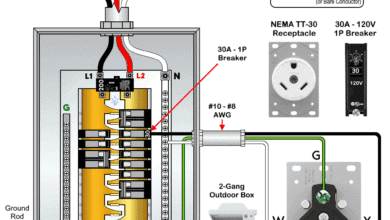Part 9 – Sizing Motor Overload Protection and OCPDs
How to Size Overload Protection for 3-Phase Motors?
NEC Article 430, Part III provides guidelines for sizing overload protection devices such as, overload relays, fuses and circuit breakers for motor branch circuit conductors against excessive heating caused by overload currents.
Overload protection for motors is required to prevent excessive current from damaging the motor windings due to prolonged overload conditions. According to NEC 2023, overload protection is sized based on 125% of the full-load current (FLC) for motors with a service factor (SF) of 1.15 or greater, or marked temperature rise of 40°C or less. For other types of motors with a service factor below 1.15 or temperature rise above 40°C, the overload protection is set at 115% of the full-load current.
An overload device for a motor can be:
- Fuses (sized in accordance with NEC 430.32(A) & 430.36).
- Inverse time circuit breakers and dual-element fuses (in accordance with NEC 430.32 and 430.55).
- Thermal overload heaters in an overload relay within a motor starter/contactor.
- Adjustable electronic solid-state overload relays in a motor starter/contactor.
Service Factor (SF) Service factor (SF) is a safety factor printed on motor nameplate. It indicates how much the motor capacity can be exceeded for a short time of period without overheating. For instance, a motor with 1.15 service factor can be operated for a short time at 15% more than its rated output without overheating. Temperature Rise A motor with a nameplate temperature rise of 40°C means it is designed to operate without exceeding 40°C above the rated ambient temperature when running at its rated load and voltage. For instance, if the rated ambient temperature is 40°C, the motor’s maximum operating temperature will be 80°C (40°C + 40°C). Studies have shown that if a motor operates 10°C above its rated temperature, the lifespan of its winding insulation is reduced by 50%.
Sizing Overload Protection for Motors
Motor starter circuits generally have built-in overload protection devices. However, a separate overload protection device (such as a thermal overload relay or a dual-element fuse) can be used and installed near the motor starter or in sequence with overcurrent protection devices (OCPDs).
When fuses are used for motor overload protection, a fuse should be installed on each ungrounded conductor (Phase, Hot, Line). Additionally, in a 3-wire, 3-phase supply with one grounded conductor, a fuse should also be installed on the grounded conductor (per NEC 430.36 for fuses on conductors and 430.55 for combined overcurrent protection in a single unit).
Hence, a single-phase AC motor may require 1 or 2 fuses, depending on the supply system, while a three-phase motor requires three fuses (one on each line) on the load end. (430.38).
If devices other than fuses (such as trip coils or relays) are used for motor overload protection, Table 430.37 shall be referenced to determine the minimum required number and placement of overload units. Additionally, overload relays used for motor overload protection must be protected by fuses or circuit breakers rated according to 430.52 for short-circuit and ground-fault protection (430.40).
According to NEC 430.6(A)(2), the motor nameplate current rating must be used to determine the value of separate motor overload protection. For motors ≤ 1 HP that start automatically, overload protection must be provided by either a separate overload device, a thermal protector, or electronic protection (per NEC 430.32(B)).
According to 430.32(A)(1), a separate overload protection device must be rated based on the motor nameplate full-load amperes (FLA) and must not exceed:
- 125% for motors with a service factor 1.15 or greater
- 125% for motors with a marked temperature rise 40°C or less
- 115% for all other motors
If the overload device sized per 430.32(A)(1) and 430.32(B)(1) cannot start the motor or carry the load current, higher overload device ratings are permitted under 430.32(C)(1), provided they do not exceed the motor nameplate full-load Amperes (FLA). This allowance exists because induction motors typically draw 6-8 times their nameplate FLA during startup.
In this case, the permitted higher overload protection limits as per NEC 430.32(C)(1)):
- 140% for motors with a service factor ≥ 1.15
- 140% for motors with temperature rise ≤ 40°C
- 130% for all other motors
This ensures that the motor can start without unnecessary tripping while still maintaining adequate protection against overload conditions.
Example 1: Sizing Overload Protection for 1-Phase Motor
How to determine the suitable size of overload protection device for the following 1/2 HP single motor operating at 230V using the motor nameplate data and ratings?
Solution:
Given data from the name plate rating:
- Motor: 0.5 HP, Single-phase
- Operating Voltage: 115-230V, 1-Phase
- FLA: 6.4-3.2A
- Service Factor: 1.15
- Temp. Rating: 40°C
1 – Find the Full Load Current
The nameplate indicates that the motor can be operated at different level of line voltages. For instance, the motor takes:
- 6.4A at 115V
- 3.2 at 230V
We have to determine the overload for 1-phase motor operated at 230V, the FLA or full load current from the nameplate is:
FLC = 3.2A
2 – Size the Overload Protection
As discussed before, the motor overload protection shall be sized based on the motor nameplate current rating in accordance with 430.32(A)(1), 430.6(A)(2) and 430.55.
since the service factor is 1.15 with temperature rating of 40°C, while the full load current (FLC) is 3.2A at 230V. The minimum overload protection can be determined using 125% of the FLA based on 430.32(A)(1).
I.e. When S.F < 1.15 & Temp. Rating = 40°C → Use 115% of FLC
Overload Protection = 3.2A × 1.25 = 4A
Hence, the minimum overload protection device should not be greater than 4A.
Example 2: Sizing Overload Protection for 3-Phase Motor
Using the following nameplate ratings and data of 5 HP multi-phase motor, what is the required size of overload protection device based on FLA operated at 460V? If the motor is unbale to carry the load current, what would be the maximum allowable overvoltage protection?
Solution:
- Given data from the name plate rating:
- Motor: 5 HP, Three-phase
- Operating Voltage: 208-230V and 460V – 3-Phase
- FLA: 13.9-13A and 6.7A
- Service Factor: 1.15
- Temp. Rating: 40°C
1 – Find the Full Load Amperes
The nameplate indicates that the motor can be operated at different level of line voltages i.e. 208V, 230V and 460V. Similarly, the rating of full load currents operated at different level of voltages based on the nameplate rating:
- 13.9A at 208V
- 13A at 230V
- 6.7A at 460V
As we have to find the overload for 3-phase motor operated at 460V, the full load amperes or current at 460V is:
FLC = 6.7A
2 – Determine the Overload Protection
According to 430.32(A)(1), 430.6(A)(2) and 430.55, the motor overload device shall be sized based on the motor nameplate current ratings.
The service factor and temperature rating is 1.15 and 40°C respectively. This way, we will use 125% of the FLA to determine the overload protection for motor in accordance of 430.32(A)(1).
Overload Protection = 6.7A × 1.25 = 8.375A
The minimum overload protection device should not be greater than 8.375A.
3 – Determine the Max. Allowable Overload Protection
If the motor doesn’t start or the overload device trips at rated load current, the maximum allowable overload protection device can be sized based on 140% according to 430.32(C)(1).
Max. Overload Protection = 6.7A × 1.4 = 9.38A
Hence, you are allowed to increase the overload protection up to 9.38A (but not exceed this value) to counter the unwanted tripping of overload circuit. In this case, the rating of OCPD or overload relay must not exceed the calculated ampacity. For this reason, the recommended size size is the next lower rating which is 9A.
Series Overview: Motor Circuit Calculations
- Part 1 – Motor Load Circuits: NEC Terms and Basic Terminologies
- Part 2 – NEC Requirements for Motor Circuits
- Part 3 – Understanding NEMA Motor Nameplate Data
- Part 4 – Calculating Locked Rotor Current (LRC) for Motors
- Part 5 – Sizing Motor Branch Circuit Conductors
- Part 6 – Sizing Motor Feeder Conductors
- Part 7 – Sizing Motor Overcurrent Protection and OCPD’s Devices
- Part 8 – Sizing Motor Feeder Protection
- Part 9 – Sizing Motor Overload Protection … (You are Here)
- Part 10 – Overcurrent Protection for Motor Control Circuits
- Part 11 – Sizing Disconnecting Means for Motor & Controller
- Part 12 – Sizing Motor Starter & Contactor – NEMA – NEC
- Part 13 – Sizing Direct Online (DOL) Starters/Contactors for Motors (*Bonus)
- Part 14 – Sizing Star-Delta Motor Starters/Contactors for Motors (*Bonus)
Resources & Tutorials:
- Cable Size Calculation for LT & HT Motors
- Three Phase Motor Power & Control Wiring Diagrams
- What is Motor Efficiency & How to improve it?
- Star Delta 3-phase Motor Automatic starter with Timer
- How to Run a Three-Phase Induction Motor on a Single-Phase Power Supply?
- How to Wire ST01 Timer with Relay & Contactor for 120V/240V Motors?
- How to Wire Twin Timer in Repeat Cycle & One-Shot Mode for 120V/240V Motors?
- How to Control a Single-Phase Motor from Multiple Locations?
- Automatic & Manual Control of Motor Using VFD & DOL Starter
- How to Reverse and Forward a Three-Phase Motor Using a VFD?
- How to Wire a VFD with Motor, PLC, Switches & External Devices
- Sequential Motor Control Circuit Using LOGO! V8 PLC
- Automatic Reverse Forward Motor Control Circuit Using Delta – DVP-14SS PLC
- Reverse Forward Motor Control Circuit Using PLC – ZEN Programming Relay
- Motor Protection – Types of Faults and Protection Devices
- Cables Feeder Protection – Faults Types, Causes & Differential Protection
Wire Sizing Guides
- How to Find the Proper Size of Wire & Cable In Metric & Imperial Systems
- How to Size a Branch Circuit Conductors with Protection?
- How to Size Feeder Conductors with Overcurrent Protection
- How to Size Service-Entrance Conductors and Feeder Cables?
- How to Size Equipment Grounding Conductor (EGC)?
- How to Size Grounding Electrode Conductor (GEC)?
- What is the Right Wire Size for 15A Breaker and Outlet?
- What is the Suitable Wire Size for 20A Breaker and Outlet?
- How Size a Circuit Breaker for Different Load Applications







